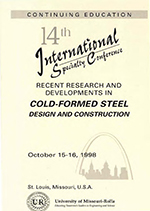Session Dates
15 Oct 1998
Abstract
In the design of pin-ended channel columns, it is necessary to account for the shift of the effective centroid caused by local buckling. The current American Iron and Steel Institute (AISI 1996) Specification and the Australian/New Zealand Standard (AS/NZS 4600-1996) for cold-formed steel structures calculate the shift by use of effective widths. However, the ability of the effective width rules to accurately predict this shift has not been experimentally assessed. In this paper, recent tests on fixed-ended channel columns are used to obtain values of the shift of the effective centroid, including its variation with the applied load. In the tests, the minor axis bending moment was measured at each end, allowing the shift of the effective centroid to be calculated as the ratio of the end moment to the applied force. The shift of the effective centroid, as predicted by the AISI Specification and the AS/NZS 4600 Standard, was shown to be inaccurate compared to the tests on lipped channels with slender flanges. This led to the abnormal result of an increase in column strength with increasing length in the design of pin-ended columns. The purpose of this paper is to use test results for plain and lipped channels to assess the ability of the effective width rules of the current AISI Specification and the AS/NZS 4600 Standard for cold-formed steel structures to predict the direction and magnitude of the shift of the effective centroid. When channel columns are loaded eccentrically from the effective centroid, the AISI Specification requires that the member be designed as a beam-column. In this case, the moment capacity calculation depends on the direction of the shift of the effective centroid and so it becomes important to predict the shift accurately both in terms of magnitude and direction. The paper proposes simple modifications to the current effective width rules that provide agreement between the measured and predicted shifts of the effective centroid.
Department(s)
Civil, Architectural and Environmental Engineering
Research Center/Lab(s)
Wei-Wen Yu Center for Cold-Formed Steel Structures
Meeting Name
14th International Specialty Conference on Cold-Formed Steel Structures
Publisher
University of Missouri--Rolla
Document Version
Final Version
Rights
© 1998 University of Missouri--Rolla, All rights reserved.
Document Type
Article - Conference proceedings
File Type
text
Language
English
Recommended Citation
Young, Ben and Rasmussen, Kim J. R., "Shift of the Effective Centroid of Channel Columns" (1998). CCFSS Proceedings of International Specialty Conference on Cold-Formed Steel Structures (1971 - 2018). 3.
https://scholarsmine.mst.edu/isccss/14iccfsss/14iccfsss-session4/3
Shift of the Effective Centroid of Channel Columns
In the design of pin-ended channel columns, it is necessary to account for the shift of the effective centroid caused by local buckling. The current American Iron and Steel Institute (AISI 1996) Specification and the Australian/New Zealand Standard (AS/NZS 4600-1996) for cold-formed steel structures calculate the shift by use of effective widths. However, the ability of the effective width rules to accurately predict this shift has not been experimentally assessed. In this paper, recent tests on fixed-ended channel columns are used to obtain values of the shift of the effective centroid, including its variation with the applied load. In the tests, the minor axis bending moment was measured at each end, allowing the shift of the effective centroid to be calculated as the ratio of the end moment to the applied force. The shift of the effective centroid, as predicted by the AISI Specification and the AS/NZS 4600 Standard, was shown to be inaccurate compared to the tests on lipped channels with slender flanges. This led to the abnormal result of an increase in column strength with increasing length in the design of pin-ended columns. The purpose of this paper is to use test results for plain and lipped channels to assess the ability of the effective width rules of the current AISI Specification and the AS/NZS 4600 Standard for cold-formed steel structures to predict the direction and magnitude of the shift of the effective centroid. When channel columns are loaded eccentrically from the effective centroid, the AISI Specification requires that the member be designed as a beam-column. In this case, the moment capacity calculation depends on the direction of the shift of the effective centroid and so it becomes important to predict the shift accurately both in terms of magnitude and direction. The paper proposes simple modifications to the current effective width rules that provide agreement between the measured and predicted shifts of the effective centroid.



